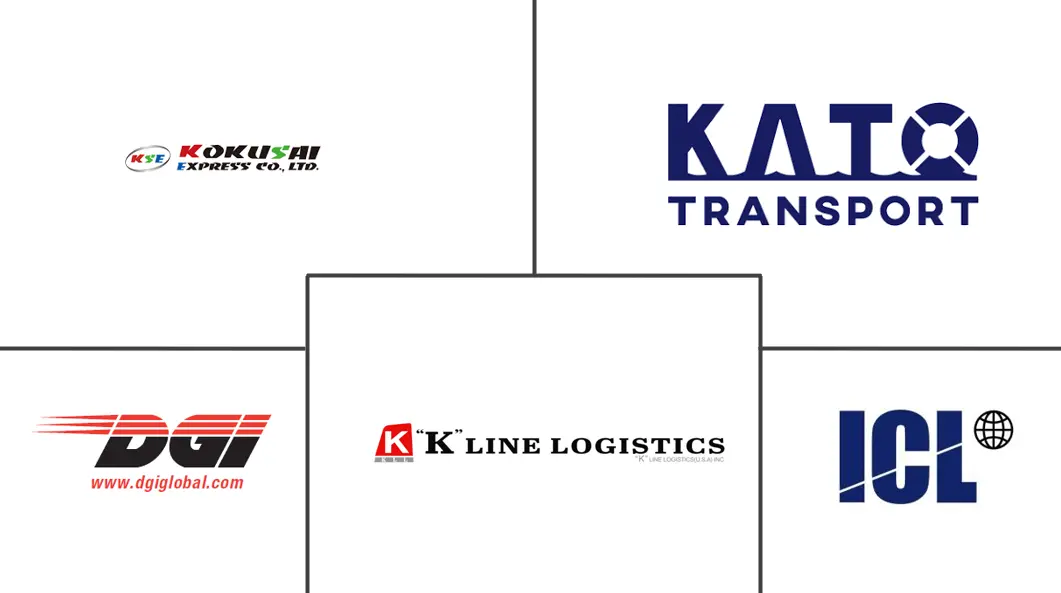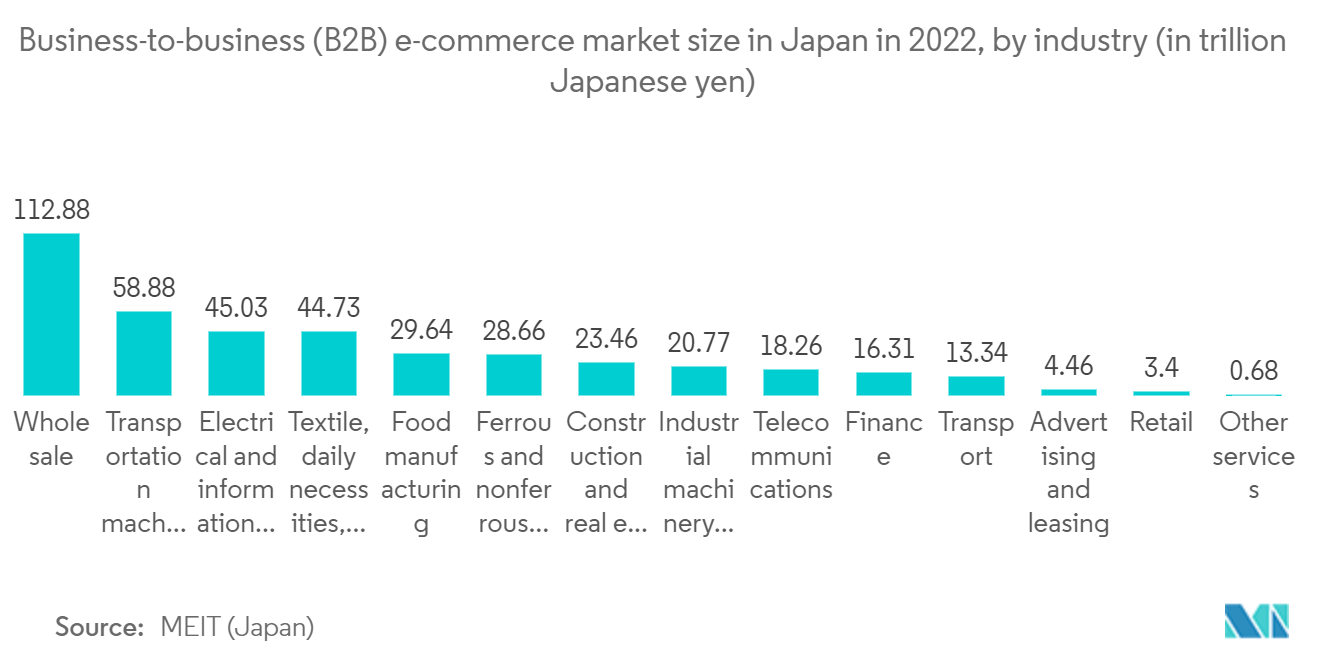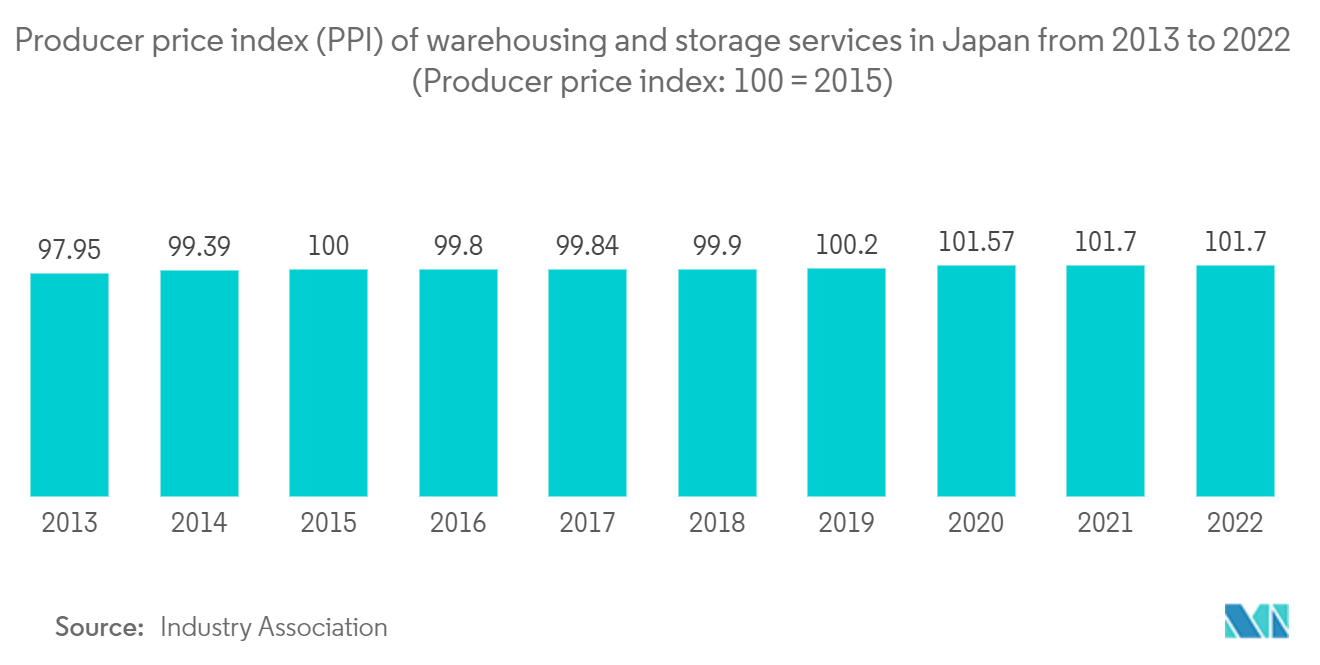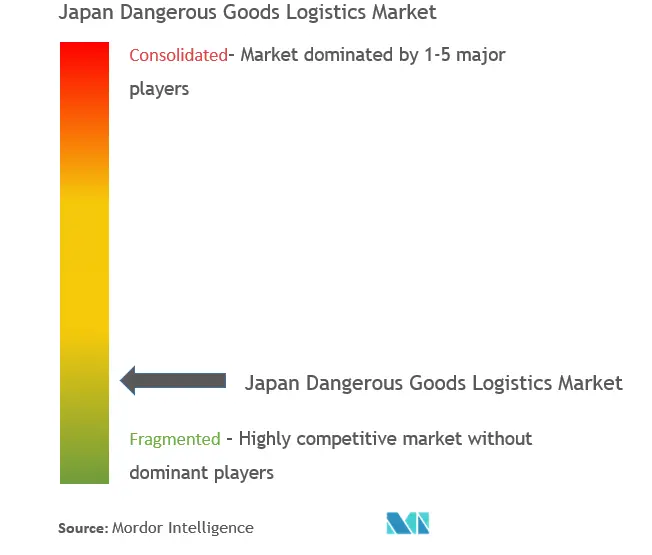Japan Dangerous Goods Logistics Market Size

| Study Period | 2020 - 2029 |
| Base Year For Estimation | 2023 |
| Market Size (2024) | USD 12.96 Billion |
| Market Size (2029) | USD 16.86 Billion |
| CAGR (2024 - 2029) | 4.71 % |
| Market Concentration | Medium |
Major Players
*Disclaimer: Major Players sorted in no particular order |
Japan Dangerous Goods Logistics Market Analysis
The Japan Dangerous Goods Logistics Market size is estimated at USD 12.96 billion in 2024, and is expected to reach USD 16.86 billion by 2029, growing at a CAGR of greater than 4.71% during the forecast period (2024-2029).
The market growth is driven by factors such as increasing demand for dangerous goods in various industries, stricter regulations for transportation and handling, and the rise of e-commerce. The major types of dangerous goods transported in Japan include chemicals, explosives, flammable liquids, and radioactive materials.
Companies are investing in technology and partnerships to address challenges like regulations and talent shortages. For instance, Mitsubishi Heavy Industries launched a smart container solution that allows the real-time monitoring of temperature and pressure for sensitive, dangerous goods.
In January 2024, the Ministry of Land, Infrastructure, Transport and Tourism (MLIT) announced revisions to the "Law on the Control of Explosives" to strengthen regulations for explosives used in construction and demolition. This could impact logistics companies transporting these materials.
In November 2023, Yamato Transport, a major logistics company, partnered with Yusen Logistics to offer specialized transportation services for lithium-ion batteries, a growing segment in the dangerous goods market. Also, in October 2023, Nippon Express, another major player, announced opening a new logistics facility in Osaka dedicated to handling dangerous goods and showcasing the industry.
Japan Dangerous Goods Logistics Market Trends
Increasing E-commerce Growth is Contributing to the Demand for Dangerous Goods
- E-commerce platforms offer a much wider variety of products compared to traditional brick-and-mortar stores. This includes a range of items classified as dangerous goods, such as electronics, cosmetics, cleaning products, and medical and laboratory supplies. Consumers expect fast and convenient delivery, which puts pressure on logistics companies to optimize their networks for the transportation of dangerous goods. This can involve dedicated trucks, packaging solutions, and trained personnel.
- Japan's e-commerce market has doubled since 2013 and is expected to continue growing. In 2022, the business-to-consumer (B2C) e-commerce market was valued at JPY 22.7 trillion, which is a 9.9% increase from the previous year. The e-commerce market is driven by Japan's high internet penetration and network infrastructure. The mobile-based app Mercari and re-commerce platforms from major B2C companies like Rakuten, Yahoo Shopping, and Amazon Marketplaces are key players in Japan's e-commerce market. A 2023 survey found that low price is the leading factor influencing the purchase behavior of almost 59% of Japanese consumers.
- The e-commerce sites in Japan offer a vast array of products. It is important to clarify that most dangerous goods are not readily available for purchase online due to strict regulations and safety concerns. However, there are some specific categories where e-commerce does play a role in facilitating the sale of certain dangerous goods. For instance, certain hair dyes, nail polishes, and even some skincare products might contain ingredients regulated as dangerous goods due to flammability or potential health risks.
- As per Volza’s Japan Export data, cleaning product shipments from Japan stood at 19.7K, exported by 1,706 Japanese exporters to 1,995 buyers. Japan exports most of its cleaning products to Vietnam, India, and Turkey. The top three exporters of cleaning products are the United States with 92,558 shipments, followed by Vietnam with 59,477, and China at the third spot with 42,909 shipments.

Increasing Demand for Warehouse Storage Infrastructures is Driving the Market
- Certain dangerous goods, like pharmaceuticals or chemicals, require specific temperature ranges for safe storage. This necessitates dedicated facilities with advanced temperature control systems. Flammable or explosive materials require specially designed warehouses with fire-resistant construction, ventilation systems, and advanced fire suppression technologies.
- Some dangerous goods, like valuable metals or hazardous materials, require enhanced security measures, necessitating warehouses with restricted access, surveillance systems, and robust security protocols.
- In July 2023, Amazon Japan announced that it would establish two new distribution hubs in Japan, one in the city of Chiba and the other in the Saitama Prefecture City of Sayama, both in the greater Tokyo area. Amazon Chiba Minato Fulfillment Center, to be created in the city of Chiba, will be the company's largest robotized hub in Japan, where robots pick up racks and move around. The automated system will help workers and reduce the time spent stocking the shelves and taking items off the racks. It also allows for more space, and the building can apparently stock up to 40% more inventory than conventional warehouses.
- NEC Corporation aims to double the efficiency of autonomous mobile robots (AMRs) deployed in warehouses across Japan by developing a new “risk-sensitive stochastic control technology” that enables them to automatically adjust their speed as they navigate the facility. The company planned to put this technology into practice by March 2024 and have it installed in NEC's cooperative AMRs in the nation. In recent years, the labor shortage has pushed large warehouses in Japan to use robots to transport materials within their facilities. These AMRs are configured to travel with reduced speed to ensure safety, making transport efficiency a challenge.

Japan Dangerous Goods Logistics Industry Overview
The Japanese dangerous goods logistics market is fragmented in nature, with a mix of global and regional players. The market is expected to grow during the forecast period due to several factors, such as e-commerce, technology integration, and growing economies. The major companies in Japan have embraced various modern technologies, such as warehousing management systems, drone delivery, and automation. They have also adopted the transportation management system, which enabled better planning and tracking facilities, resulting in increased productivity and value proposition. The major players in this market are Kokusai Express, SAGAWA Global Logistics, Nippon Express, K Line Logistics, and Yusen Logistics.
Japan Dangerous Goods Logistics Market Leaders
-
Kokusai Express
-
"K" Line Logistics Limited
-
KATO Transport
-
DGI (Dangerous Goods International) Global
-
ICL Logistics Japan Co Limited
-
Yusen Logistics Limited
*Disclaimer: Major Players sorted in no particular order

Japan Dangerous Goods Logistics Market News
- December 2023: Imec and Mitsui Chemicals entered a strategic partnership on the commercialization of carbon-nanotube (CNT) based pellicles for extreme ultraviolet (EUV) lithography. Under this partnership, Mitsui Chemicals plans to integrate imec’s fundamental CNT-based pellicle innovation into Mitsui Chemicals’ CNT pellicle technology to achieve full production specifications, targeting its introduction in high-power EUV systems in the 2025-2026 timeframe.
- April 2023: Nippon Express Ltd received IATA CEIV Pharma certification on April 26, 2023, for its facility at Heathrow Airport. The certification is a quality certificate for pharmaceutical transport established by IATA.
Japan Dangerous Goods Logistics Market Report - Table of Contents
1. INTRODUCTION
- 1.1 Study Assumptions
- 1.2 Scope of the Study
2. RESEARCH METHODOLOGY
3. EXECUTIVE SUMMARY
4. MARKET INSIGHTS
- 4.1 Current Market Scenario
- 4.2 Industry Value Chain Analysis
- 4.3 Government Regulations and Initiatives
- 4.4 Brief on Dangerous Goods Classes
- 4.5 Technology Snapshot
- 4.6 Impact of COVID-19 on the Market
5. MARKET DYNAMICS
-
5.1 Market Drivers
- 5.1.1 Growing Demand for Dangerous Goods
- 5.1.2 Increasing E-commerce Growth
-
5.2 Market Restraints
- 5.2.1 Lack of Qualified Personnel
- 5.2.2 Infrastructure Limitations
-
5.3 Market Opportunities
- 5.3.1 Technological Advancements
- 5.3.2 Partnerships and Collaborations in the Industry
-
5.4 Industry Attractiveness - Porter's Five Forces Analysis
- 5.4.1 Bargaining Power of Suppliers
- 5.4.2 Bargaining Power of Buyers/Consumers
- 5.4.3 Threat of New Entrants
- 5.4.4 Threat of Substitutes
- 5.4.5 intensity of Competitive Rivalry
6. MARKET SEGMENTATION
-
6.1 By Service
- 6.1.1 Transportation
- 6.1.2 Warehousing and Distribution
- 6.1.3 Value-added Services
-
6.2 By Destination
- 6.2.1 Domestic
- 6.2.2 International
7. COMPETITIVE LANDSCAPE
- 7.1 Market Concentration Overview
-
7.2 Company Profiles
- 7.2.1 Kokusai Express
- 7.2.2 "K" Ling Logistics Limited
- 7.2.3 KATO Transport
- 7.2.4 DGI (Dangerous Goods International) Global
- 7.2.5 ICL Logistics Japan Co Limited
- 7.2.6 Nippon Express
- 7.2.7 Yamato Transport
- 7.2.8 Chikko Corporation
- 7.2.9 LOGISTEED Japan Ltd
- 7.2.10 Yusen Logistics
- 7.2.11 Mitsui Chemicals
- 7.2.12 SAGAWA Global Logistics
- 7.2.13 Uyeno Logichem Ltd*
- *List Not Exhaustive
- 7.3 Other Companies
8. FUTURE OUTLOOK OF THE MARKET
9. APPENDIX
** Subject To AvailablityJapan Dangerous Goods Logistics Industry Segmentation
Dangerous goods logistics is the transportation of hazardous substances by air, sea, or road. Dangerous goods (DG) are substances that pose a risk to health, safety, property, or the environment when transported. They can be categorized as flammable, explosive, radioactive, bio-hazardous, or allergenic.
The Japanese dangerous goods logistics market is segmented by services (transportation, warehousing & distribution, and value-added services) and destination (domestic and international). The report offers market sizes and forecasts in terms of value (USD) for all the above segments.
| By Service | Transportation |
| Warehousing and Distribution | |
| Value-added Services | |
| By Destination | Domestic |
| International |
Japan Dangerous Goods Logistics Market Research FAQs
How big is the Japan Dangerous Goods Logistics Market?
The Japan Dangerous Goods Logistics Market size is expected to reach USD 12.96 billion in 2024 and grow at a CAGR of greater than 4.71% to reach USD 16.86 billion by 2029.
What is the current Japan Dangerous Goods Logistics Market size?
In 2024, the Japan Dangerous Goods Logistics Market size is expected to reach USD 12.96 billion.
Who are the key players in Japan Dangerous Goods Logistics Market?
Kokusai Express, "K" Line Logistics Limited, KATO Transport, DGI (Dangerous Goods International) Global, ICL Logistics Japan Co Limited and Yusen Logistics Limited are the major companies operating in the Japan Dangerous Goods Logistics Market.
What years does this Japan Dangerous Goods Logistics Market cover, and what was the market size in 2023?
In 2023, the Japan Dangerous Goods Logistics Market size was estimated at USD 12.35 billion. The report covers the Japan Dangerous Goods Logistics Market historical market size for years: 2020, 2021, 2022 and 2023. The report also forecasts the Japan Dangerous Goods Logistics Market size for years: 2024, 2025, 2026, 2027, 2028 and 2029.
Japan Dangerous Goods Logistics Industry Report
Statistics for the 2024 Japan Dangerous Goods Logistics market share, size and revenue growth rate, created by Mordor Intelligence™ Industry Reports. Japan Dangerous Goods Logistics analysis includes a market forecast outlook for 2024 to (2024to2029 and historical overview. Get a sample of this industry analysis as a free report PDF download.



